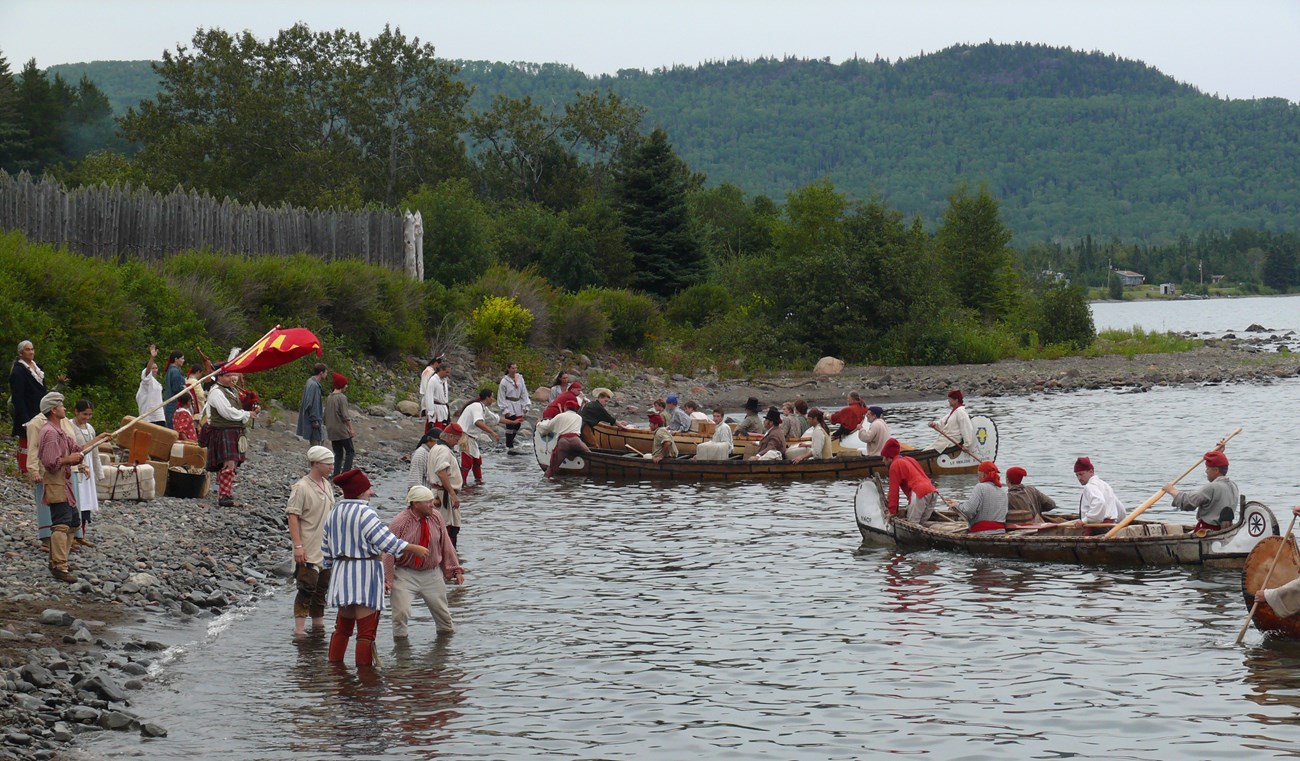Last updated: December 21, 2023
Article
The Men of the Voyageurs Encampment

NPS photo
The Men of the Voyageurs Encampment
Voyageurs, North Men and Montrealers, made up the bulk of the fur trade employees at Grand Portage. These hardy souls would spend weeks to months in the wilderness transporting trade goods to remote posts either in canoes or on their backs. Read further to learn about their lives and working conditions.
The Voyageurs:
-
Most, but not all of the Voyageurs were French Canadian, meaning that they originally came from the area along the Saint Lawrence River between Montreal and Quebec.
-
The vast majority of them were not formerly educated and could neither read nor write.
-
To work for the company they had to sign contracts. Some of the North Men chose to remain in the north country when their contracts expired to become free men. As a free man they could subcontract out to the company for varying lengths of time doing various jobs for any company that wanted to hire them. They also hunted, trapped, and traded with Native Americans on their own. It was very difficult to get their furs back east however and they usually wound up selling them to whichever company would offer them the best price.
-
Pay: '' ... the fur trade was structured so as to balance the books on the backs of the poorest-paid employees. While wages nominally went up between 1767 and 1800, few workers actually made money, and many ended up owing the company. In 1791 it was said that nine hundred men owed more than ten or fifteen years' pay. They were usually in debt from the moment they started, since they had to borrow from the company for any extra clothing or equipment. The wintering voyageurs were paid once a year at Grand Portage, but they were paid in goods or in vouchers for merchandise from the company-run story. Because of the inflated prices at Grand Portage, the pay was worth only two-thirds of what it would have been in Montreal. In addition, the company made a 50 percent profit on any goods purchased with bons. Sales to its own employees were absolutely crucial to the company. "Were it not that the Men Spend their Wages and the extraordinary high price of Bears and Beaver it would be to us a loosing [sic] business," one partner wrote." Carolyn Gilman, The Grand Portage Story, page 68
The Montrealers:
-
Also called the porkeaters (mangeurs de lard) because the company fed them a daily ration of one quart of either peas or parched corn and a pound of fat.
-
These were the seasonal voyageurs that left Montreal with the trade goods in the spring, loaded in the "Montreal canoes" (canots du maître), and returned with the furs in the fall.
-
It took them about six weeks to two months to travel the 1200 miles between Montreal and Grand Portage. There were about 36 portages along this route.
-
While at the Rendezvous they were required to haul eight packs of trade goods up over the Grand Portage trail to Fort Charlotte and haul eight bales of fur back down to Grand Portage while they are at the Rendezvous. The company would pay them for any extra bales that they cared to haul over the portage at this time.
-
The voyageurs had to provide seven days of labor while at the Rendezvous, by contract or corvée, to the company. This could consist of operating the fur presses, repairing buildings, cutting firewood, pit sawing lumber, taking care of the gardens and livestock, etc.
-
Some of these voyageurs would be asked to become North Men to replace those whose contracts were up and wished to go back east. Before they became a North Man, they would have to sign a three to five year contract with the company.
The North Men:
-
Between 300-600 North Men (hommes du nord) or "winterers" (hivernants) would have been camping along the shoreline outside the stockade while they are at the yearly rendezvous. Grand Portage was a welcomed respite for the North Men who had spent the past two months or more paddling and portaging furs from the interior trading posts. For this part of the journey, smaller "north canoes" (canots du nord) were used to navigate the inland waters.
-
While at the Rendezvous, besides their pay and rationed food supply, they would also receive two pairs of trousers, two shirts, and two blankest for the upcoming year.
-
There were some North Men from the far distant posts, such as the Athabasca district, that were too far away to make it to the Rendezvous at Grand Portage. For them, the company sent a special convoy of canoes with trade goods to meet them at Rainy Lake where they would hold a mini Rendezvous of about a week before they returned to their wintering posts. Even·so some of them would be hard pressed to get back before winter set in by the end of October.
-
There were about 36 portages between Grand Portage and Rainy Lake and it took the voyageurs about two weeks to get there.
-
These voyageurs did not only paddle and portage goods but were required to be jack-of-all- trades. Some became proficient black smiths, carpenters, coopers, and a few were good hunters. It seems that they were very good at repairing canoes, but few learned the skills necessary to build a canoe from scratch. They delivered mail between posts, fished, went out to the hired hunter camps to haul meat back to the trading post, and went on trading missions with the clerks or wintering share partners during the winter to visit Native American camps. Very few voyageurs actually did any trading for furs with the Native Americans on behalf of the company. This was the job of the wintering share partner and his clerks.

NPS photo
